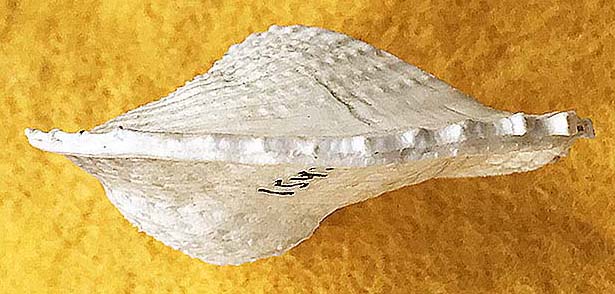Genus Corculum cardissa (Linnaeus, 1758) is commonly referred to as the “heart cockle” because of its “valentine” shape. This clam belongs to family Cardiidae. This clam, like its six other sister species, harbors the symbiotic dinoflagellate known as Symbiodinium in its mantle and gills. This dinoflagellate (also known as a zooanthellae) is used as food for the clam. In addition, this clam obtains oxygen (for physiological purposes) from this dinoflagellate. In turn, Corculum cardissa provides a “home” for the dinoflagellate.
The unusually shaped shell of C. cardissa is attached to the ocean floor by a few filaments. The underside valve of C. cardissa is flattened and also so thin that it is transparent, thereby allowing light to penetrate its shell, and this light is used for photosynthesis by the dinoflagellate. The upper valve of this clam is usually covered by filamentous algae or mud.
Kawagutii (1949) did the pioneering studies of the symbiotic relationship between Corculum and Symbiodinium. For more information about algal-bivalve photo-symbiosis, see Ohno et al. (1995).
An articulated (= both valves) specimen of Corculum cardissa: top, bottom, and left-side views, length 4.5 cm, width 4 cm.
A different specimen of Corculum cardissa with its valves separated: A) oblique bottom view of both valves (length 2.5 cm) showing the hinge. B) and C) perpendicular bottom views of left and right valves (length 2.5 cm, width 1.3 cm), respectively, showing the hinge.
References:
Kawagutti, S. 1949. Observations on the heart shell, Corculum cardissa (Linnaeus) and its associated zooxanthellae. Pacific Science 4(1):43–49. [online pdf free]
Ohno, T. , T. K. and T. Yamasu. 1995. The origin of algal-bivalve photo-symbiosis. Paleontology 38:1–21, 1 pl. [requires a subscription]






No comments:
Post a Comment